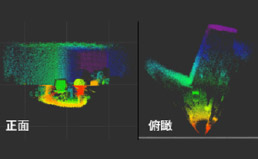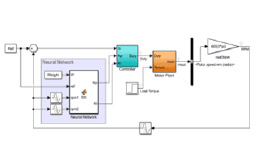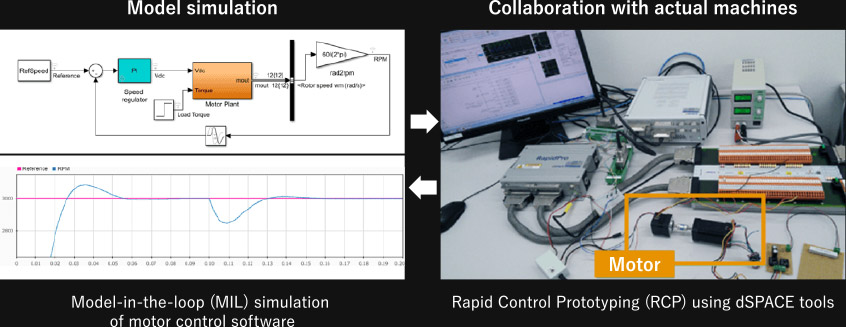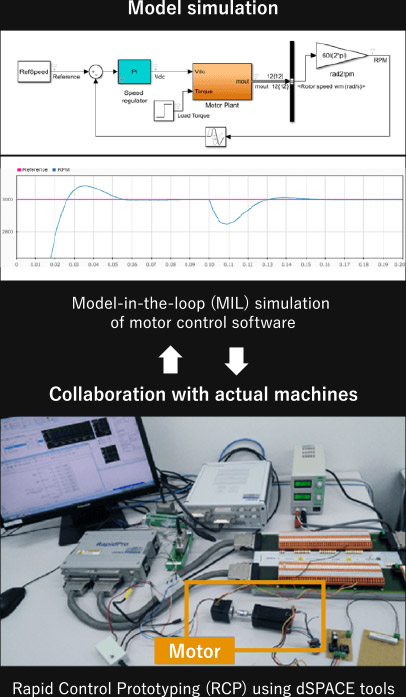Model-Based Development
Efficient embedded software development through Model-Based Development
SANEI HYTECHS is committed to model-based development using Mathworks' MATLAB/Simulink and dSPACE's prototyping units.What is Model-Based Development?
Model-based development (MBD) is a method for designing software using models. A model is often referred to as a "living specification document."
Since the models themselves serve as specifications, ambiguities caused by natural language can be eliminated. Furthermore, development can proceed even when the actual software programs or physical components, such as motors, are not yet available. This approach is generating significant interest in large-scale embedded software design projects.
The adoption of model-based development for efficient V-shaped development is accelerating, particularly due to the increasing complexity of automotive development.
For more information about MBD, please refer to our company's development department efforts.
Since the models themselves serve as specifications, ambiguities caused by natural language can be eliminated. Furthermore, development can proceed even when the actual software programs or physical components, such as motors, are not yet available. This approach is generating significant interest in large-scale embedded software design projects.
The adoption of model-based development for efficient V-shaped development is accelerating, particularly due to the increasing complexity of automotive development.
For more information about MBD, please refer to our company's development department efforts.
Advantages of Model-Based Development
Compared to traditional software development, model-based development eliminates ambiguities caused by natural language because the models themselves serve as specifications. It is also possible to generate software code from the models, which can prevent human errors caused by hand-coding. Moreover, using models for verification allows for the identification of issues or defects even when the actual software programs or physical components, such as motors, are not yet available.
In embedded software design (especially in the automotive industry), there is a strong demand for design efficiency due to the increasing scale of software and the need for shorter delivery times, resulting in a growing need for model-based development.
In embedded software design (especially in the automotive industry), there is a strong demand for design efficiency due to the increasing scale of software and the need for shorter delivery times, resulting in a growing need for model-based development.
Workflow of Model-Based Development
In model-based development, the goal is to implement a "model" (a control system built as a mathematical model on a computer) on an "actual machine" (real ECU or motor).
However, if the designs in the model are suddenly replaced with actual machines, there would be significant setbacks if the verification fails.
As a result, the development process starts with Model-in-the-loop Simulation (MILS), where control algorithms are studied using only the model. Then, the process moves to Software-in-the-loop Simulation (SILS), where the control section is replaced with source code, and finally to Hardware-in-the-loop Simulation (HILS), where the control software is implemented on actual hardware while the control target remains a model. Throughout these stages, parts of the model are gradually replaced with actual machines, and the results from MILS, SILS, and HILS are compared.
The photo on the right in the "Brushless DC Motor Control Design Case Study" shows an example of evaluating control algorithms using an actual machine control target early in the development process. This is called Rapid Control Prototyping (RCP). The control software uses a model, while the control target is an actual motor for simulations.
However, if the designs in the model are suddenly replaced with actual machines, there would be significant setbacks if the verification fails.
As a result, the development process starts with Model-in-the-loop Simulation (MILS), where control algorithms are studied using only the model. Then, the process moves to Software-in-the-loop Simulation (SILS), where the control section is replaced with source code, and finally to Hardware-in-the-loop Simulation (HILS), where the control software is implemented on actual hardware while the control target remains a model. Throughout these stages, parts of the model are gradually replaced with actual machines, and the results from MILS, SILS, and HILS are compared.
The photo on the right in the "Brushless DC Motor Control Design Case Study" shows an example of evaluating control algorithms using an actual machine control target early in the development process. This is called Rapid Control Prototyping (RCP). The control software uses a model, while the control target is an actual motor for simulations.
Utilizing Model-Based Development
Model-based development is an efficient design method, but it encompasses a wide range of essential technologies, such as modeling techniques, plant model identification, generating large numbers of test cases, automating verification, and building in-the-loop simulations.
In addition, we are also tackling topics related to model-based development, such as 3D computer graphics simulations, processing point cloud data from LiDAR and image data from cameras, and automatic control tuning using deep learning.
In addition, we are also tackling topics related to model-based development, such as 3D computer graphics simulations, processing point cloud data from LiDAR and image data from cameras, and automatic control tuning using deep learning.

3D Computer Graphics Simulation
Driving simulation using Unreal Engine
Driving simulation using Unreal Engine

LiDAR/Camera Data Processing
Processing point cloud data from LiDAR sensors
Processing point cloud data from LiDAR sensors

Deep Learning
Automatic control tuning using deep learning
Automatic control tuning using deep learning
Case Studies
Our company is committed to model-based development using Mathworks' MATLAB/Simulink and dSPACE's prototyping units.
Brushless DC Motor Control Design Case Study
As an example, we will introduce a case study of control design for a brushless DC motor.
The control of a brushless DC motor involves adjusting the duty ratio of the PWM wave supplied to the motor driver according to the difference between the target speed and the current speed.
In an excellent control software, the motor's rotation speed instantly follows the target speed even when the load on the motor changes or the target speed is adjusted.
The control of a brushless DC motor involves adjusting the duty ratio of the PWM wave supplied to the motor driver according to the difference between the target speed and the current speed.
In an excellent control software, the motor's rotation speed instantly follows the target speed even when the load on the motor changes or the target speed is adjusted.


Providing design services tailored to model-based development, increasingly adopted in the automotive industry
As automobile development advances, the adoption of model-based development (MBD), which has unique characteristics not found in conventional development, is accelerating in the automotive industry. SANEI HYTECHS responds to this market change by preparing its own MBD-focused curriculum and training engineers. Additionally, we offer transition services that convert "existing design assets" not based on MBD into models, which can then be utilized in subsequent MBD-based development. Please entrust us with new control model designs using model-based development with tools like Mathworks' MATLAB/Simulink.
MORE
MORE
-
Collaborative Design of Digital and Software (Zynq/Intel SoC)
-
Development of high-performance ADCs
- Achievements / Case | LSI Circuit Design | ADC
- Pipeline ADC / Cyclic ADC IP development
- SARADC / OS-SARADC IP development
- Delta Sigma (ΔΣ) ADC IP development
- 【Coming Soon】Development of high-performance ADC IP peripheral circuits (PGA, BGR, RCOSC)
- In-house Developed Analog IP Service
- Development of circuit boards and systems for ADC evaluation
![[Image]SANEI HYTECHS](/en/shared/img/logo_w.png)